Warrnambool Greyhound Racing
LCA: Warrnambool City Council
Club President: Robert Gore
Manager: Craig Monigatti
Tel: (03) 5561 2766
Email: warrnambool@grv.org.au
Website: warrnambool.grv.org.au
Address: Warrnambool Showgrounds, Koroit Street, Warrnambool
Postal: PO Box 115, Warrnambool 3280
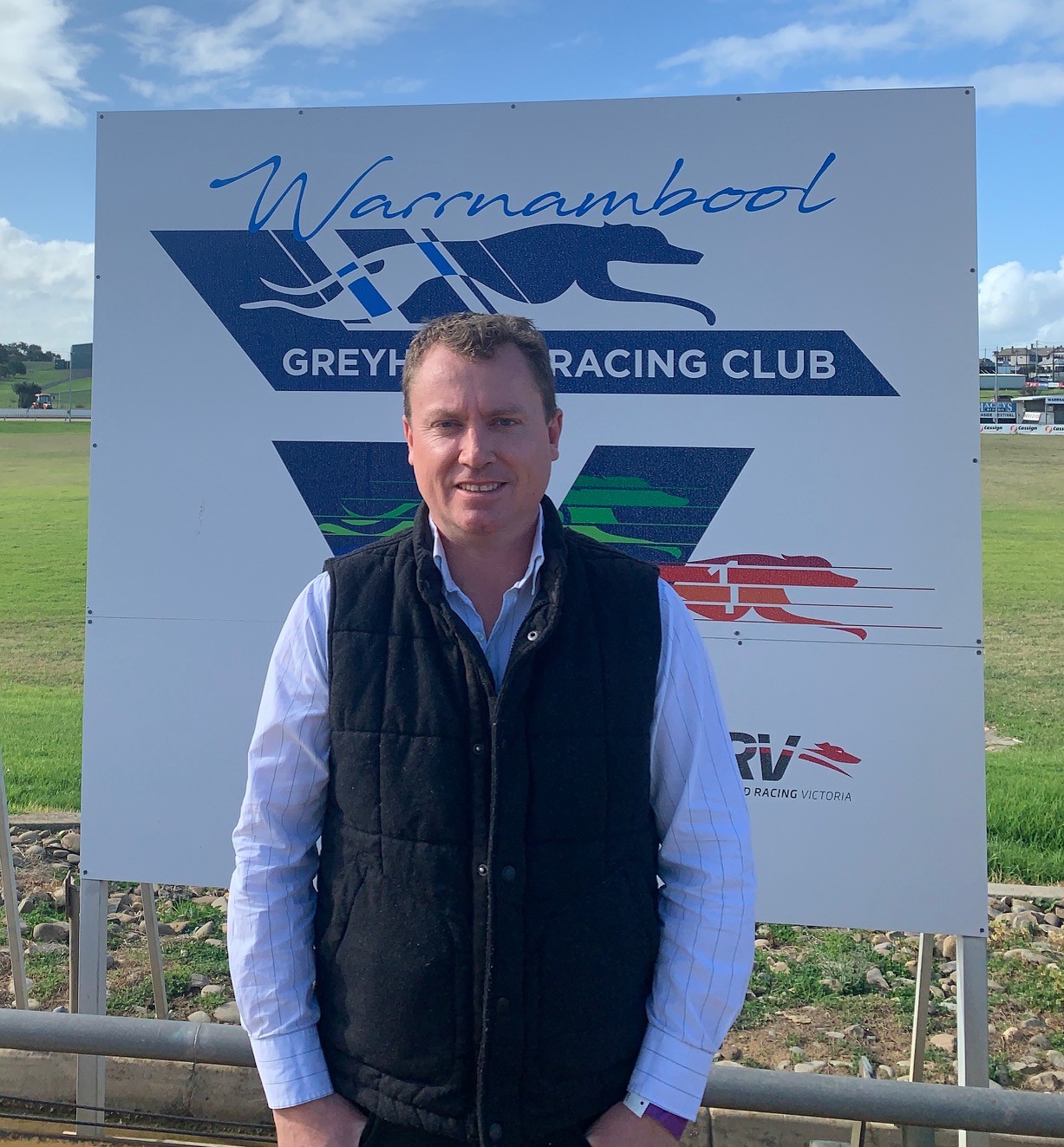
Craig Monigatti
Craig an all-round good guy and was born in Casterton in Western Victoria. After completing primary school, the family moved to Warrnambool when he was 7, for a better education. Craig moved to Ballarat to attend University, upon finishing school where he completed a Bachelor of Human Movement and a Bachelor of Management.
In 2002 Craig headed for the big city of Melbourne to start full time work at the Carlton Football Club. Working in administration for a VFL team, then organising their traveling, clothing, administration support for coaches and football managers.
Craig found a passion for stats and was promoted to Video and Statistics Manager working alongside coaches in planning and reviewing of matches and players. Ending up as the Football Technology Manager and Head Performance Analyst at the Carlton Football Club.
Craig worked with the following senior coaches Wayne Brittain, Denis Pagan, Brett Ratten, Mick Malthouse, Brendon Bolton and with Ross Lyon before he became a senior coach.
After 14.5 years and working in all football departments, Craig started his role at Warrnambool Greyhound Racing in 2016 and has since completed a Master of Business (Sport Management) from Deakin University.
Craig has one beautiful daughter, Stella and is a long-suffering Carlton supporter.
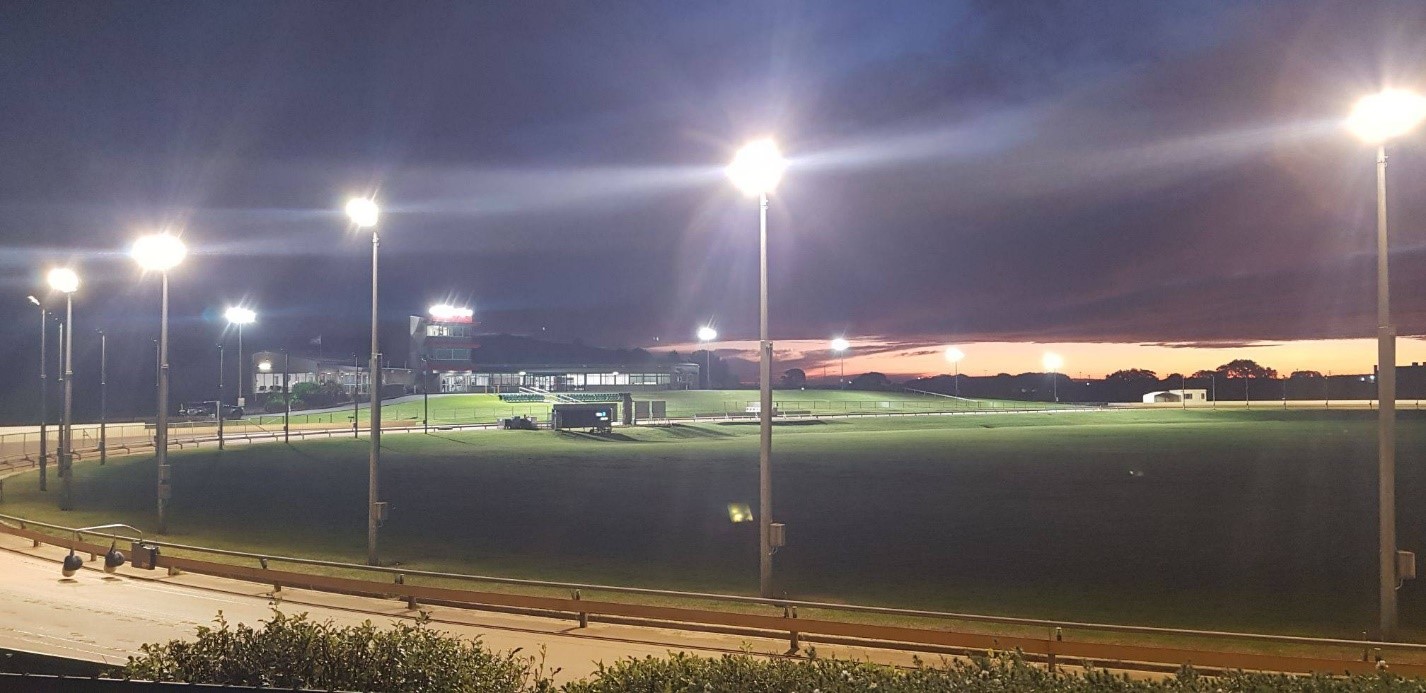
HISTORY OF THE WARRNAMBOOL GREYHOUND RACING CLUB
In the early days of racing, there were several small tracks around the outskirts of Warrnambool. One was a 300-yard grass straight track at Bushfield, approximately four miles out of Warrnambool and racing on a Saturday afternoon before good crowds with a bus running to the meeting and the local pub was close by.
Around 1931, another track sprung up at the rear of the Christian Brothers College on the outskirts of Warrnambool. The popularity of greyhound racing during this period saw a Plumpton club opened at Wangoom, a small town just out of Warrnambool.
In 1933, Bill Gleeson, who owned the hotel, offered £50 ($3500) to establish the Warrnambool Greyhound Racing Club. A public meeting raised £300 ($21,000) and a further £800 ($55,000) was raised after public canvassing. Debentures were offered at £5 ($350) and, by reports, they '"went off quick"'.
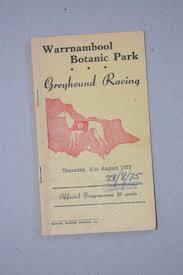 In 1936, a new track was opened on some very low ground on the corner of Botanic and Queens Roads, just below the Botanic Gardens. The initial course was a single grass track of some 300 yards. In 1937, the club created a circular type track of 388 yards. The new circuit was shaped as a horseshoe, with a good run home to the finish from where it linked up with a straight track.
In 1936, a new track was opened on some very low ground on the corner of Botanic and Queens Roads, just below the Botanic Gardens. The initial course was a single grass track of some 300 yards. In 1937, the club created a circular type track of 388 yards. The new circuit was shaped as a horseshoe, with a good run home to the finish from where it linked up with a straight track.
Opening night saw a crowd of 1200 people and dignitaries, including the National Coursing Club Secretary Roy Maidment and White City and Gracedale Park manager Harry Heggart. Both made glowing speeches, the local brass band entertained and the 10-race program, including two hurdle races was keenly supported. The first race was won by Hopeful Andrew owned by club President P O’Keefe who collected £17 ($1140) prize money. All this could have been obtained in chose days; or the admission fee of 2 shillings ($7) for gentlemen and 1 shilling for ladies.
The standout greyhound of this period was Warrnambool Hall of Fame member Adoree, owned by Percy Levy and Stan McNamara. Levy trained their greyhounds and had a saddler's shop in Warrnambool. The success of the greyhounds that he sold nationally and internationally established the area’s reputation for breeding and raising good greyhounds.
During the next 10 years, the Speed Coursing Club raced on Friday nights at Whiteway, as the track at Botanic Park was known; and the Plumpton Racing Club raced during Saturday afternoons. As was the case with all clubs, the enforced security restrictions during WWII meant all night racing was banned and Saturday afternoons became the norm.
Life was always exciting at Botanic Park. The Whiteway track was situated in a natural hollow with a local creek running right through its grounds so flooding was a fact of life at Botanic Park. In 1946, the district experienced one of the worst wet weather periods ever recorded and the huge floods that followed turned the track area into a lake.
The tendency for the track to become completely fog bound proved to be an additional hazard. There were sheep grazing in the middle of the Park and if the handlers were not fast enough catching the greyhounds at the end of the race, the greyhounds would leap the barriers and start playfully chasing the sheep, adding to the handlers’ woes.
The Club Steward was local schoolteacher Bob Allen. One night, Bob, a strong enforcer of the rules, refused a major '"identity'" entry to a race because he arrived five minutes late. The identity took his greyhound home and returned determined to deck Alan. Alan beat him to the punch and to add insult to injury, the stewards handed out a five-year suspension on the spot. The next day, this penalty was commuted to five days.
When the club purchased Botanic Park from the Raynor family in 1968, the horseshoe track had decaying equipment, the rail was made of water pipes supplied by Nestles and the driving mechanism for the lure was an old car. The cables that dragged the lure were handed down from Sandown. These often broke leading to the cancellation of the races.
By 1976, the club was faced with vast expenditure to upgrade facilities that were desperately in need of repair. The move to the Warrnambool Showgrounds, which was located on Crown land, meant that the State Government would provide funding for the development of the Wannon Park track. The final meeting at the Botanic Road site was held in 1978 before an exceptionally large crowd, which saw the Norm McCullagh trained Luskadena win the last race. If bookies turnover was any indication, the move to bigger and better facilities was warranted.
Jack Daffy, Club President from 1971-1982 remembers changes to the way the sport was run. He is proud of the fact that Warrnambool was the first club in Victoria to operate with electric lights, to use electric timing, to employ a fulltime secretary, to use telex to distribute information and to appoint a veterinarian to the club to examine greyhounds before they raced. Any greyhound that was put out of a race was suspended for 28 days, which discouraged owners from entering greyhounds that were not well prepared.
While the shift was initially a great success, it produced some unexpected changes. Norm McCullagh remembers that the new two-turn track and the shift from grass to sand favoured stronger, fitter greyhounds. With favourites winning more often the bookies found the going tough and their numbers dwindled. The declining odds on offer led to declining attendances and forced the Club to cut prize money by 25%.
Jack Daffy saw 27th July 1978 as the dawning of a new era of greyhound racing in Warrnambool when the lights of the new $290,000 ($970,000) track were turned on for the first time at the Showgrounds site. Racing commenced in late August with a huge crowd in attendance. The new track was opened by GRCB Chairman, Charles Petty. The first race was won by Skyline Blue, sired by the mighty Temlee, trained by committee-man Bill Kermod and bred by Club Chairman Jack daffy.
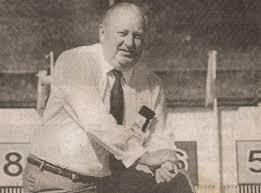 In 1986. The late Stan Lake was elected President and took on the task of revitalising the club. The old Botanic Park track was sold to the Parish priest for a school. Paid staff were replaced with volunteers from the local branch of the GOTBA and the Ladies' Committee. Hurdle racing was introduced, proved successful, and saw the crowds return to the Park.
In 1986. The late Stan Lake was elected President and took on the task of revitalising the club. The old Botanic Park track was sold to the Parish priest for a school. Paid staff were replaced with volunteers from the local branch of the GOTBA and the Ladies' Committee. Hurdle racing was introduced, proved successful, and saw the crowds return to the Park.
Stan Lake was on the Club Committee from 1952 and was President from 1986 to 1997, in all 46 years with the Club. His achievements and dedication were recognized in the naming of the Stan Lake Pavilion at Wannon Park and the Stan Lake Invitation Special.
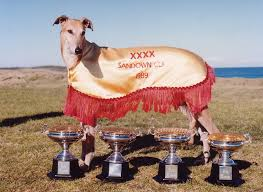 Stan's best greyhound was Indian Fighter, which won two Warrnambool Cups and two ANZGRA cups. However, the 1980s belonged to the legendary Bold Trease, owned by Norm and Alan McCullagh and trained by Norm. Bold Trease won four successive Sandown Cups, a record unlikely to be surpassed.
Stan's best greyhound was Indian Fighter, which won two Warrnambool Cups and two ANZGRA cups. However, the 1980s belonged to the legendary Bold Trease, owned by Norm and Alan McCullagh and trained by Norm. Bold Trease won four successive Sandown Cups, a record unlikely to be surpassed.
The hard work took the club from one of the lowest to the highest stake paying non-TAB club in country Victoria. After many deputations to the GRCB and the Racing Minister, the club was granted its first TAB meetings, which were staged on April 25th and 30th 1985.
In 1991, after three years of planning, the first Warrnambool Classic was run. The race was held over three weeks in April and was sponsored by Macey’s Bistro who supported the race from 1995. It began with $100,000 ($160,000) in stakes $350 ($560) coming from each of the 700 greyhounds entered. At the time and for a long period it was the only race of its type and it drew a large number of entries from all over Australia.
Maureen Drennan, daughter of Stan Lake and Club Secretary at the time, remembers that a huge effort was required to keep the club on a secure financial footing. Picnic meetings, "guess the legs" and it also heavily discounts venue hire rates for any charitable organizations to raise funds competitions, dress up competitions and bingo were all designed to maintain interest in the club. Maureen believes running the Cup and the Classic on the same night in 2000, while a controversial move at the time, proved to be highly successful element of the Club's strategy.
The Club has continued to thrive. In 2001, the club paid out $775,000 ($960,000) in prize money including $50,000 ($61,000) to the winner of the Macey's Bistro Classic. It was the richest provincial meeting in Australia and the race was supported by a strong base of breeders and trainers until the concept and race was discontinued in 2018.
In January 2007, the club celebrated its 80th Anniversary by inducting eight greyhounds into its Hall of Fame. On the charity front, the Club has donated $2,500 to the South West Healthcare as part of a neo-natal unit in 2008 and it also heavily discounts venue hire rates for any charitable organizations to raise funds.
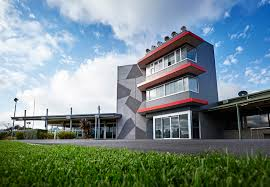 In 2009, a brand-new track at the Warrnambool Greyhound Racing Club was officially opened by GRV Chairman, the late Mrs. Jan Wilson. A hundred guests witnessed the Wednesday night opening, at which Warrnambool’s Club President Phil Mitchem thanked Jan Wilson, the GRV Board and the GRV Senior Management Team for having the confidence in the Club to make the $1.9m investment. The project replaced the track surface and lighting, realigned the track at the top bend to provide for easier negotiation, and brought the track nearer to the viewing areas.
In 2009, a brand-new track at the Warrnambool Greyhound Racing Club was officially opened by GRV Chairman, the late Mrs. Jan Wilson. A hundred guests witnessed the Wednesday night opening, at which Warrnambool’s Club President Phil Mitchem thanked Jan Wilson, the GRV Board and the GRV Senior Management Team for having the confidence in the Club to make the $1.9m investment. The project replaced the track surface and lighting, realigned the track at the top bend to provide for easier negotiation, and brought the track nearer to the viewing areas.
On the night the GRV Chairman commented that Sky Channel had indicated that the new Warrnambool track is the best in Australia, and the views of seasoned trainers from all over Victoria endorse that opinion. She added that Warrnambool was one of Victoria's most proactive race clubs and had an excellent relationship with the Warrnambool community including excelling in their involvement with the annual Great Chase.
The club unveiled a 1.4-million-dollar upgrade at the 2019 Warrnambool Cup meeting. Work at the venue contained significant improvements to the track and the facilities on course. The function rooms are state of the art and classed among the top three in the District.
WARRNAMBOOL CUP
Club Presidents 1936-1938 P O’Keefe, 1938-1942 D Melican, 1942-1947 D McCarthy, 1947-1951 P Sheppard, 1951-1956 L. Irvine, 1956-1958 L. Jenkins, 1958-1961 E Cain, 1961-1962 S Lake, 1962-1971 J Maloney, 1971-1982 J Daffy, 1982-1986 G Parsons, 1986-1997 S Lake, 1997-1998 J Fisher, 1998-2003 P Keane, 2003-2004 L Brookes, 2004-2009, P Mitchem. 2019-Current M White Update of the Warrnambool Presidents P.Mitchem 2004-2016, R.Lane 2016-2019 and M.White 2019-current.
Listed below are the past winners of the Warrnambool Cup. It is believed the Cup was conducted on the old Warrnambool track as far back as 1961 but records since 1972 show that many a top performer has won the feature event over the years.
1972 Tien Shan, 1973 Natural Power, 1974 Uba Lass, 1975 Sylvan Prince, 1976 Busy Penny, 1977 Tem Dasher, 1978 Roisheen’s Son, 1979 Imaturner, 1980 Tempix, 1981 Kuda’s Talent, 1982 So Blue, 1983 Lady Lilly, 1984 Super Mira, 1985 Kilmarney Lad, 1986 Larrikin Lewis, 1987 McWilliam Boy, 1988 High In Space, 1989 Gun Fury, 1990 Hard Rain, 1991 McGuane, 1992 Bomber Gleeson, 1993 Nova Express, 1994 Fitzroy Express, 1995 Midnight Flirt, 1996 Morrant, 1997 Another Currency, 1998 Macorna Lad, 1999 Honcho Classic, 2000 Kantarn Bale, 2001 Sweet Silkab, 2002 Kantarn Bale, 2003 Francesca Bale, 2004 Harvey Bale 2005 Sun Hero, 2006 Brilliant Lee, 2007 Axe Handle 2008 El Galo, 2009 Hanify’s Impact, 2010 Nova Surf, 2011 Arsonist, 2012 Dyna Bert, 2013 Ronan Izmir and 2014 Black Magic Opal, 2015 Ronray Spirit, 2016 Zambora Brockie, 2017 Leo’s Gift, 2018 Striker Light, 2019 Dyna Patty, 2020 Zambora Smokey.
WARRNAMBOOL CLASSIC
The Warrnambool Classic was first conducted by the club in 1991 with greyhound pups nominated in record numbers during early 1990. Like any event of its type the actual race is exceedingly difficult to win given the length of time involved from rearing to racing. The Honour roll contains some outstanding winners some of which have gone on to win group one features and in the case of Brett Lee inducted into the AGRA-GCA Hall of Fame. The Classic was discontinued in 2018.
1991 Kinta’s Way, 1992 Wild Pirate, 1993 Dinney’s Host, 1994 New Locomotion, 1995 Prince Of Thiefs, 1996 Blue Volcano, 1997 Fine Carousel, 1998 Witch Honcho, 1999 At The Helm, 2000 Our Daisy, 2001 Brett Lee, 2002 Zed Three, 2003 Brumby Lad, 2004 That’s Critical, 2005 Ace Hi Rumble, 2006 Auf Wiedersehen, 2007 Deception Bay, 2008 Lynlea’s King, 2009 Bordain, 2010 Cosmic Chief, 2011 Compacto, 2012 El Brooklyn, 2013 Premier Event, 2014 Magic Diva, 2015 Nunya Tron, 2016 One For Me, 2017 Bewildering.
